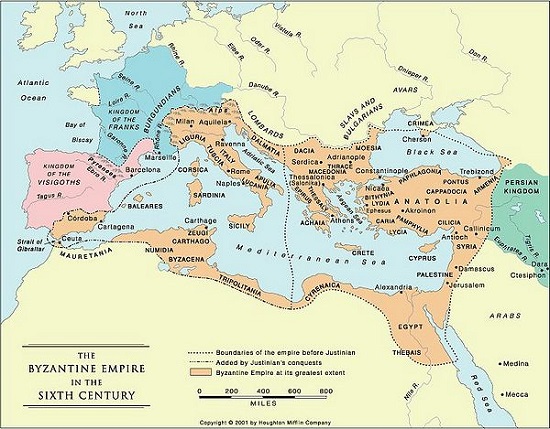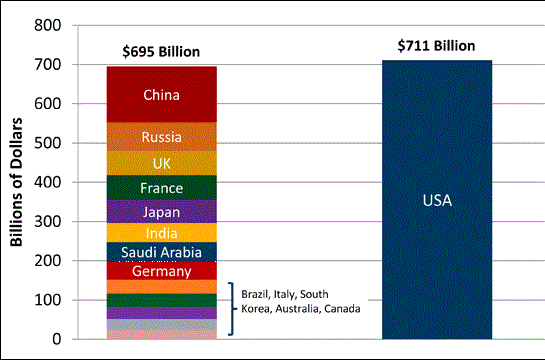Trying to reduce the carefully choreographed drama to one stage and one audience risks misunderstanding the signal.
It seems many media observers are confused by events in Syria and the swirl of competing narratives. Did the Swamp drain Trump? Did the Neocons succeed in forcing Trump to follow their lead? Is the U.S. ramping up yet another endless war?
Consider the possibility that none of these narratives actually get to the heart of what's going on. To make sense of all this, we're going to have to delve into topics far below today's headlines.
I think Ilargi (The Automatic Earth) got it right in his recent essay Symbols of Strength, in which he proposed that the entire cruise-missile exercise had little to do with Syria and everything to do with signaling Trump's willingness to use force to China's President Xi jinping.
Signaling is a term that is currently much in vogue. I used it in my recent essays Virtue-Signaling the Decline of the Empire (February 28, 2017) and It's What's Happening Beneath the Surface That Matters.
The original idea of signaling, drawn from economist Michael Spence's job-market signaling model, has become confused with communication.
Spence proposed the notion that a college degree bridges the asymmetrical information gap between employer and employee: the employer has a tough time obtaining useful information on the qualifications and intelligence of job applicants. A college degree signals employers that the applicant is perseverent enough to get through 4+ years of college, and has enough intelligence (and work ethic) to earn the diploma.
Here is Bloomberg writer Noah Smith's description of the difference between signaling and communicating: "Spence’s signaling model was about proving yourself by doing something difficult -- something so difficult that someone who didn’t have what it takes wouldn't even bother."
In other words, communication isn't a signal. A quizzical raised eyebrow, a scoffing chuckle, a wry comment--all of these telegraph emotional content as well as information. But these are not signals.
A signal is a form of communication, but its cost must be high to be persuasive.A signal can provide information on intent, depth of commitment, willingness to accept risk and much more.
A signal is often intended to communicate different things to different audiences.
To understand signaling, we need to understand the difference between force and power. Edward Luttwak ably described the difference in his book The Grand Strategy of the Roman Empire: force is a mechanical input (expense) that doesn't scale: it takes a lot of people, effort and treasure to force others to comply with Imperial edicts.
Power, on the other hand, is ultimately the sum total output of the Empire: its productive capacity, resources, human and social capital--everything. Power influences others without direct coercion. This allows the Empire to extend its influence without having to bear the enormous costs of applying force.
Luttwak explains that power results from positioning military assets to serve political-power objectives. That is, the assets must be positioned to credibly threaten the use of force anywhere in the Empire, but the job of maintaining influence/control is done more by signaling the readiness and ability to use force rather than having to put the force in the field (a very costly and risky venture that often turns out badly).
In other words, the perception of power and the willingness and ability to apply force is what matters in terms of political influence. If we look through this lens, we discern a much different picture of what may be going on with the cruise missile attack on Syria.
(I also recommend Luttwak's companion volume, The Grand Strategy of the Byzantine Empire.)
The "Secret Sauce" of the Byzantine Empire: Stable Currency, Social Mobility(September 1, 2016)

Here is some essential context for the signaling of the U.S., Russia and China.The U.S. spends roughly $700 billion annually on its Armed Forces and another $100 billion on intelligence agencies and defense-related expenditures. So round it up to $800 billion.

That is roughly 15% of total federal spending, and a bit over 3% of America's GDP. Historically, these are very low numbers. In other words, the U.S. isn't even spending much of its total available output on its military.
Every great power aims its signals at both the international audience and the domestic audience. Rather than being a poker game, signaling is more 3-D chess, with three boards in play at all times: client states and allies; potential adversaries, and the domestic audience.
China, Russia and the U.S. are all signaling to these three different audiences with every pronouncement and every action.
We must be careful not to misread a signal primarily intended for a domestic audience as being more than a symbolic act. All the analysts who see the cruise-missile attack as "proof" that the Swamp has drained Trump, or the U.S. intends to raamp up its involvement in Syria are looking at only one board--or they've misread the game entirely, and are glued to a PR sideshow.
A successful signal performs on multiple levels, leveraging the effect at a low cost. No Great Power can afford to use only brute force to maintain influence. Signals may be directed at multiple audiences, and trying to reduce the carefully choreographed drama to one stage and one audience risks misunderstanding the signal.
The entire cruise-missile drama hints at the possibility that U.S. Neocons are being played. It's all too pat for my taste. But that's a topic for another essay.
For those interested in Imperial strategies, force and power, I recommend these books as worthy starting places. I am not an authority, I am only an avid amateur, so please let me know which other books you've found to be especially insightful.
How Rome Fell: Death of a Superpower (Adrian Goldsworthy)
War and Peace and War: The Rise and Fall of Empires (Peter Turchin)
The Rise of Rome: The Making of the World's Greatest Empire (Anthony Everitt)
428 AD: An Ordinary Year at the End of the Roman Empire (Giusto Traina)
Genghis Khan and the Making of the Modern World (Jack Weatherford)
Venice: A New History (Thomas F. Madden)
Byzantium: The Surprising Life of a Medieval Empire (Judith Herrin)
This essay was drawn from Musings Report 14. The Reports are emailed weekly to major contributors and patrons ($50 annually or $5/month or higher).
If you found value in this content, please join me in seeking solutions by becoming a $1/month patron of my work via patreon.com.
If you found value in this content, please join me in seeking solutions by becoming a $1/month patron of my work via patreon.com.
Check out both of my new books, Inequality and the Collapse of Privilege ($3.95 Kindle, $8.95 print) and Why Our Status Quo Failed and Is Beyond Reform ($3.95 Kindle, $8.95 print). For more, please visit the OTM essentials website.
NOTE: Contributions/subscriptions are acknowledged in the order received. Your name and email remain confidential and will not be given to any other individual, company or agency.
Thank you, Karen H. ($5/month), for your splendidly generous pledge to this site -- I am greatly honored by your support and readership.
|
Thank you, Michael D. ($5/month), for your superbly generous pledge to this site -- I am greatly honored by your support and readership.
|
